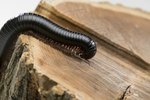
Pill bugs are class Crustacea creatures that are significantly more similar to shrimp and lobsters than to insects, despite their somewhat deceptive, insect-like exteriors. These wee isopods often reside in outside settings, but also sometimes find their way into human structures. Like to many other types of animals, pill bugs are equipped with a handful of useful survival adaptions.
Basic Information
Pill bugs have dark, flattish physiques. They have tiny white limbs that are hard to detect, even though they have seven sets of them total. They also have antennas. Their typical living environments are soggy areas that are devoid of much light -- think piles of foliage and below decaying logs, for example. Pill bugs are sometimes even found in pet food bowls that are kept outdoors. These guys usually are anywhere between a quarter-inch and half-inch in length. They have the distinction of being the sole crustaceans that live fully on terra firma. More than 3,800 species of pill bugs exist internationally. They are often considered to be pests, although they aren't harmful to people. Pill bugs don't carry illnesses, nor do they sting or bite.
Curling Up Into Balls
Many pillbugs are capable of warding off predators by curling their tiny bodies up into balls. They react to annoyance and fearful situations by immediately taking on this conspicuous shape -- a defensive adaptation that's the reason behind their common name. It actually stops a lot of their predators -- such as the praying mantis -- from being able to successfully get through their shells, which are extremely hard.
Rapid Walking
A lot of pill bugs are also capable of walking speedily, which also can be helpful for self-protection purposes. Pill bugs have a wide array of potential predators, including tiny mammals, amphibians, spiders and reptiles. Pill bugs are also nocturnal creatures, which also allows them to stay out of many predators' sights.
Water Conservation
Pill bugs also often have survival adaptations that enable them to maintain adequate water levels. Their nocturnal behavior also helps them in this respect, as nighttime air also isn't as dry. In times of extremely arid weather, pill bugs also cope through huddling their bodies together. Doing this minimizes moisture loss via the skin. Without sufficient moisture, pill bugs rapidly pass away.
References
- University of Arizona Center for Insect Science: Isopod, Pillbug, Sow Bug Information
- American Orchid Society: Pill Bugs and Sow Bugs
- University of Kentucky College of Agriculture, Food and Environment: Sowbugs and Pillbugs
- University of Michigan BioKIDS: Pillbugs
- Calvin College: Pill Bugs
- Iowa State University Department of Entomology: Sowbugs & Pillbugs
Photo Credits
-
Jupiterimages/Photos.com/Getty Images




